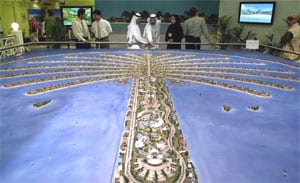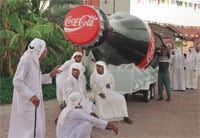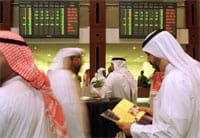Awash With Liquidity
Skyrocketing oil prices have brought a flood of liquidity into the Middle East, providing vast opportunities for fleet-footed investors and financial institutions.

|
The near doubling of crude oil prices over the past 18 months has generated enormous revenues for the oil-rich states of the Middle East. As a rough measure, each additional dollar on the price of oil results in an extra $6 billion of revenues for the Middle Eastern OPEC members, who between them are sitting on more than two-thirds of the worlds proven reserves.
Nor is this flow of money into the Middle East likely to dry up in the immediate future. A continuing high-price environment is certainly what both the oil futures markets and most independent experts expect. Leo Drollas of the London-based Centre for Global Energy Studies says: Over the next 18 months oil prices will stay high. I only see them starting to drift downwards after 2006.
Some blame hedge funds and other speculators for this. However, as Walid Shihabi, head of research at the Dubai-based investment bank SHUAA Capital, points out, Political tensions between Iran and the US have rendered ample room for speculation. He also notes that we have been here before. Reminiscing back to the wake of the 1979 Iran Revolution, when oil prices surged past $80 [in todays money], fund managers have priced in the possibility of the US waging another war in the Middle East.
What has changed since the previous oil price spikes in the 1970s, following the Arab-Israeli war, and the early 1980s after Ayatollah Khomeinis rise to power is that this time most of the extra oil money is staying in the Middle East region. Previously there was a strong counter-flow of petrodollars back into OECD economies. This time, Shihabi notes, the same region is witnessing massive growth in financial assets and real estate prices amid a windfall of liquidity on the back of record-high oil prices.
Certainly, local stock markets have experienced a momentous bull run. Over the three years from end-April 2002, during which time oil prices have stayed above $25 a barrel, Dubais stock market rose by 768%, Qatars by nearly 600%, and Kuwaits by 326%, while Saudi Arabia posted a more modest 288% gain. The overall index for stock markets in the Gulf Co-operation Council area has nearly trebled, with some of the most spectacular gains in Qatar and elsewhere coming through earlier this year.
Real estate prices have rocketed, as massive projects, including what is promised to be the worlds tallest tower going up in downtown Dubai, get the go-ahead. With such investment opportunities so close to home, why look further abroad? In addition, there is a widespread inclination among the regions private sector investors, especially since 9/11 and the selective freezing of assets by the US and its allies, to keep more of their money within the Middle East. And while there are many plausible explanations for so sharp a rise in asset valuesnotably, improvements at the geopolitical level combining with more mature and diversified economies to offer the prospect of sustainable growththere can be no doubting what is the primary driver of the current boom. The entire region is awash with surplus liquidity.
And so far only a fraction of the burgeoning oil revenues has entered the local economies. These are government revenues, after all, paid directly by state-owned oil and gas companies into the state coffers. Normally they are held in overseas assets such as treasury bills and other bonds and only repatriated when needed to fund government expenditure programs. It is at this stage, when they are converted into the local currency, that additional liquidity is created. However, the expectation of these capital flows has stimulated bank lending, thereby creating further liquidity. No wonder that this massive windfall resulting from the hydrocarbons boom, as Shihabi puts it, has created what can be described as the Gulfs black gold rush.
Those countries that had racked up high debt/GDP ratios during the low oil price environment of the 1990s are now paying down their debt. Saudi Arabia, where public debt rose to above 100% of GDP, paid down $12 billion last year, according to Drollas. Currently, Saudi debt is down to 71% of GDP, and given that the countrys surplus on the fiscal side is set to rise to $56 billion compared to $26 billion last year, further debt reduction is anticipated. But since most of those bonds were held by Saudi commercial banks and two large government pension funds, one of the results of paying down public debt is to inject further liquidity into the private sector.
Brad Bourland, chief economist at the Saudi American Bank, points out that the sharp reduction in the debt/GDP ratio is not so great as it seems because Saudi Arabias GDP has grown so rapidly. He believes the authorities are going for a gradual run-down of debt, which is being achieved simply by not issuing any new bonds. Theyre not going into the market place and retiring debt prematurely. And with money supply currently growing at around 20%, theres no need to inject more liquidity into the system, he says.
|
Caveat Emptor |
|||
Bourland differentiates between Saudi Arabia, with its relatively large population, diverse economy and requirements for infrastructure and other investments, and the smaller oil-rich Gulf statesKuwait, Qatar, the United Arab Emirates (UAE)where there are fewer channels for redirecting the immense incoming capital flows. Shihabi points out that much of the UAEs stock market gains have been on the back of booming real estate and construction sectors. A lot of money is chasing relatively few real opportunities. The cowboys are out in force, he warns, and they are trying to use such seemingly legitimate means as capital markets to scoop the largest share of wealth away from investors. Beware the hollow IPO.
Since many of the regions capital markets are relatively immature and are only just opening up to foreign investors, it is hardly surprising, says Shihabi, that the returns generated from the massive gains witnessed in Gulf markets over the past three years have been captured almost completely within the region, with only a handful of niche emerging markets fund managers involved. The opening of new, more sophisticated international financial exchanges in Dubai and Doha may change that. However, given that the regions combined stock markets are now trading at an average p/e of 32 times earnings, outside investors may find it hard to identify value. Oil revenues may have brought new opportunities in the Middle East. But it is very much a homegrown affair, and structural barriers to redirecting these immense capital flows more efficiently still remain in place. |
Regional Liquidity Management Becomes More Sophisticated

|
|
|
The agencies responsible for investing Middle East governments oil wealth are among the largest and most influential players in the global market. The Abu Dhabi Investment Authority, for instance, controls assets estimated at around $500 billion, making this oil-rich emirate the best financially endowed county in the world on a per capita basis.
In many of the smaller Middle East countries a proportion of this wealth is set asidein a fund for future generationsagainst the time when oil revenues start drying out. Most of these assets are invested outside the region, in government bonds, real estate and strategic equity stakes.
The Kuwait Investment Authoritywhose enormous accumulated assets took a serious dent when that country paid its agreed share for its liberation from Saddam Hussein in the first Gulf War, but which has since rebuilt its asset base to the tune of hundreds of billionsmanages investments for the future on a graduated basis, with a higher proportion going to their fund for future generations when the oil price rises above set parameters.
Saudi Arabia is the exception to this rule, having a larger population and therefore greater calls for government spending on infrastructure and social programs. The Saudis just spend on projects, says Leo Drollas of the Centre for Global Energy Studies. That is partly driven by five-year plans but also by what the Saudi royal family want to do. With big infrastructure projects these often turn out to be white elephants.
The big government investment authorities, which control so much of the oil wealth, are in for the long term and have traditionally pursued fairly conservative investment strategies. That is not to say that they are not extremely sophisticated investors, applying the full panoply of financial vehicles to grow their assets and hedging against adverse foreign exchange movements and other possible threats.
There are signs that some government investment authorities are now pursuing more activesome would say predatoryinvestment strategies. The UAE, with its more developed financial infrastructure, is taking the lead here, both in terms of more cross-border joint ventures within the region and through the acquisition of key stakes in global companies. Dubai, for instance, is now one of the largest stakeholders in Daimler-Chrysler.
Whereas far more of the oil wealth is now remaining within the region, the balance is invested further afield. Certainly capital flows into global markets get a boost during oil-boom years, says Walid Shihabi, head of research at SHUAA Capital. Nowadays the infrastructure in terms of capital markets, investment banking and fund management capabilities needed to redirect those capital flows is far better developed.
Shihabi points to new laws being introduced across the region that are more conducive to redirect investment to where it can gain a better return, along with the ongoing liberalization of the financial industry to allow more players, both domestic and international, to tap these markets. He also sees the opening of new markets such as the Qatar Financial Centre and the Dubai International Financial Exchange (DIFX) this September (see page 30) as introducing more international standards to the regions capital markets. Over the long term that should bring more depth to these markets as well, he notes.
Jonathan Gregson




